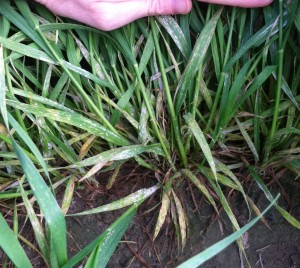As the wheat crop approaches the flag leaf emergence growth stage, it is time to start thinking about disease management. When conditions are conducive to disease development (e.g. high humidity, warm temperatures) foliar fungicide applications may be necessary to protect wheat yield and quality. The mild winter in 2014/2015 resulted in early onset of foliar diseases in some areas, and powdery mildew and rust were reported from a few fields as early as December. Recently, powdery mildew has been reported from throughout Virginia, leaf blotch has been observed in southeastern Virginia, and leaf and stripe rust have been reported just south of Virginia in North Carolina.
Once the flag leaf emerges, this leaf surface, which feeds the developing grain, should be protected from disease if symptoms are observed on the lower leaves and conditions are conducive to disease development. Fungicides containing a strobilurin should not be applied after heading but are a good option for control of foliar diseases as the flag leaf emerges. Late applications of strobilurins can increase DON (vomitoxin) if scab infections occur during flowering. Triazoles including Caramba, Proline, and Prosaro are good options for scab control and will also control late-season foliar disease. Currently, scab risk in the region is low but growers should consult the FHB prediction tool (http://www.wheatscab.psu.edu/) as the crop gets closer to flowering. Ideally, fungicide applications should be made based on scouting and/or risk of infection and disease development due to weather conditions. A fungicide efficacy table for many of the products registered for wheat can be found below.
2016 Wheat Fungicide Efficacy Table
As always, for more information on disease management in field crops feel free to contact Dr. Hillary Mehl, Extension Plant Pathologist by email (hlmehl@vt.edu) or phone (757-657-6450 ext. 423).

